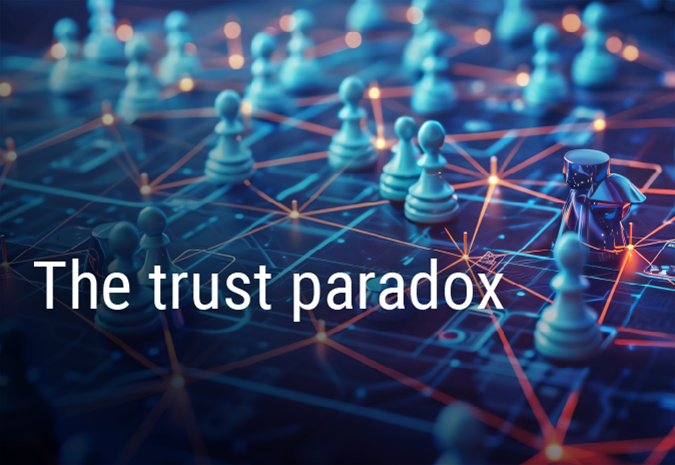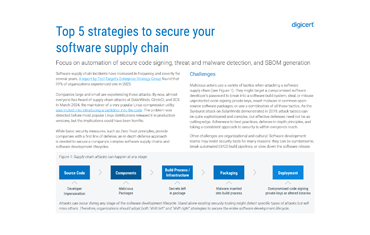
Outside the context of cybersecurity, trust is an emotion, a hard-to-measure feeling you have about something or someone.
But trust means something different in the digital world. Here, it’s more like a piece of architecture—the foundation of a tall building or a sturdy bridge that makes it possible to travel from shore to shore.
When that metaphorical bridge breaks, the damage stretches far beyond the source. A breach of trust in cybersecurity sends shockwaves rippling outward, touching every corner of an organization—and in some cases, threatening its collapse.
As our reliance on technology grows—and as artificial intelligence (AI) becomes more deeply embedded in our lives—the boundaries of trust are being tested like never before. In cybersecurity, AI is both an adversary and an ally. And if there’s one thing I’ve learned in my nearly three decades in the industry, it’s that the future of digital trust lies not in choosing between human expertise and AI capabilities but in creating synergies between the two.
The role of AI in cybersecurity
Artificial intelligence is reshaping cybersecurity at an unprecedented pace, offering both powerful solutions and complex challenges. It’s a paradox of progress: AI’s ability to solve problems simultaneously creates new ones, requiring constant adaptation to balance its promise against its pitfalls.
How AI strengthens security
AI has brought a lot of good to cybersecurity, allowing organizations to detect anomalies in real time, automate incident response, and predict vulnerabilities so they can address risk proactively.
These advancements don’t just enhance efficiency. They also transform security professionals from firefighters into strategists. Since AI can handle repetitive tasks, the humans that used to spend their working hours performing those tasks now have the time and mental energy to focus on innovation, training models, and high-level decision-making that help a business grow.
The rise of AI-driven threats
Those same tools that can help fortify your defenses are being weaponized by attackers. Malicious actors are now using AI to launch attacks that are more personalized, scalable, and difficult to detect—things like crafting convincing phishing emails, using deepfake technology to spread disinformation, and creating adaptable threats that learn how to circumvent traditional security measures.
What makes these cyber threats so dangerous is their speed and sophistication. Unlike traditional cyberattacks, which often follow predictable patterns, AI-enabled attacks can adjust in real time, outpacing static defenses.
AI’s relationship to trust
AI and digital trust are inextricably linked. The same technology that can help bolster trust through stronger security measures can just as easily undermine it when weaponized. This push and pull creates a dynamic that forces organizations to navigate AI’s dual nature with caution, responsibility, and foresight.
To build and sustain trust in an AI-driven world, your organization needs to focus on three key principles: transparency, accountability, and adaptability.
Transparency: AI that builds confidence
For AI to enhance trust, it must be understandable. When organizations deploy AI tools, stakeholders—whether employees, customers, or regulators—need to know how these systems work. Black-box AI, where decisions are made without clear explanations, can erode trust instead of building it.
Explainable AI (XAI) is essential in this context. By making AI systems and models transparent, your organization can show exactly how decisions are made, ensuring accountability and reducing fears of hidden flaws, biases, or malicious tampering.
Accountability: Owning the outcomes
AI systems are only as good as the data and logic they’re built on, which means organizations must take responsibility for their AI-driven outcomes—both positive and negative. Companies that prioritize accountability are the ones that deliver trust consistently.
To do this, you need to make sure that AI decisions align with ethical principles, respecting data privacy and maintaining fairness. Your organization must also be ready to own its mistakes, communicate them clearly, and take swift corrective action.
Accountability doesn’t just apply to AI itself—it extends to the people and processes surrounding it. Clear governance frameworks, regular audits, and robust fail-safes are essential to maintaining stakeholder confidence.
Adaptability: Thriving in a changing landscape
The pace of AI innovation means threats are constantly evolving. The organizations that succeed in building trust will be the ones that remain agile—continuously learning, adapting, and improving their defenses against potential threats.
AI offers a powerful way to stay ahead of attackers, but it requires more than just deploying the latest technology. Success comes from integrating AI into a broader culture of resilience, where every team member understands their role in protecting the organization and its stakeholders.
The Phoenix effect: How to recover from broken trust
Even with the best defenses, incidents happen. And when they do, trust tends to plummet. But trust, while fragile, isn’t beyond repair.
In the aftermath of a breach, organizations have an opportunity to prove their commitment to security by handling the incident with integrity. I’ve seen companies rise from these moments stronger than before by focusing on three critical steps:
- Acknowledging with transparency: Honest communication is the foundation of rebuilding trust. Stakeholders need to hear about the incident directly and in clear terms—no sugarcoating, no delays.
- Providing clarity on remediation efforts: Explain what went wrong, what’s being done to fix it, and how future risks are being mitigated. A vague response won’t cut it. People need specifics to regain confidence.
- Committing to long-term improvements: A quick fix isn’t enough. Demonstrating that the organization is serious about learning and improving requires sustained efforts—things like implementing newer security measures and conducting regular reviews.
This approach leads to what I call the “Phoenix effect,” allowing organizations to transform a crisis into a catalyst for meaningful change.
Building an ecosystem of security and trust
Achieving and maintaining trust requires a fundamental shift in how organizations view security. It’s not a checkbox or a one-time investment—it’s a cultural cornerstone.
Organizations that weave security into their DNA are better equipped to handle both the opportunities and challenges AI brings. This means fostering a mindset of vigilance, collaboration, and accountability at every level, from the C-suite to frontline teams.
In a world where trust and technology are deeply intertwined, security must become everyone’s responsibility.
Playing the long game
Trust isn’t static—it’s a dynamic, ongoing process that requires constant care and attention. And as AI continues to evolve, so too will the challenges and opportunities it brings to cybersecurity.
Organizations that embrace AI as both a tool and a challenge, commit to transparency and accountability, and foster a culture of resilience will not only survive but thrive.
Because at the end of the day, trust is more than an emotion; it's more than even just a foundation or a bridge. It’s a blueprint—a way to navigate uncertainty, build stronger connections, and thrive in a world where the one and only constant is change.
The latest developments in digital trust
Want to learn more about topics like digital trust, artificial intelligence, and cybersecurity? Subscribe to the DigiCert blog to ensure you never miss a story.






